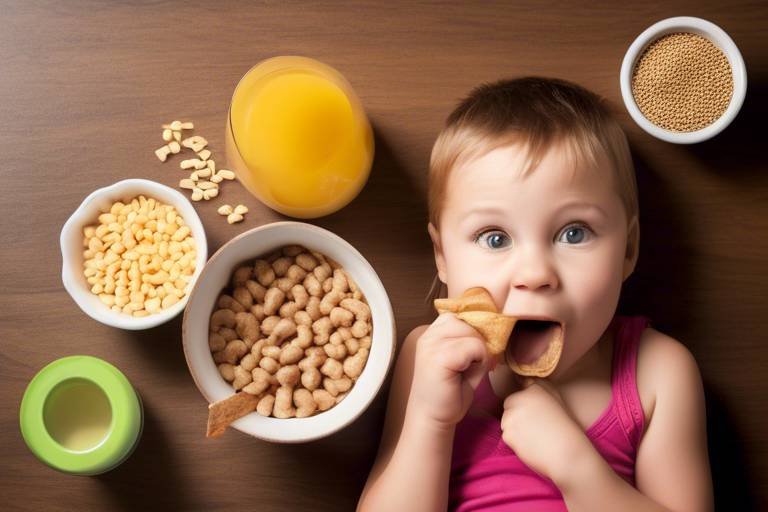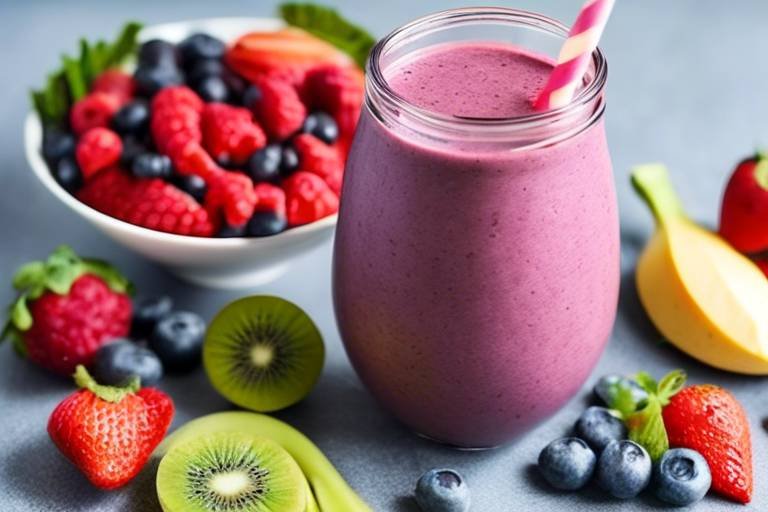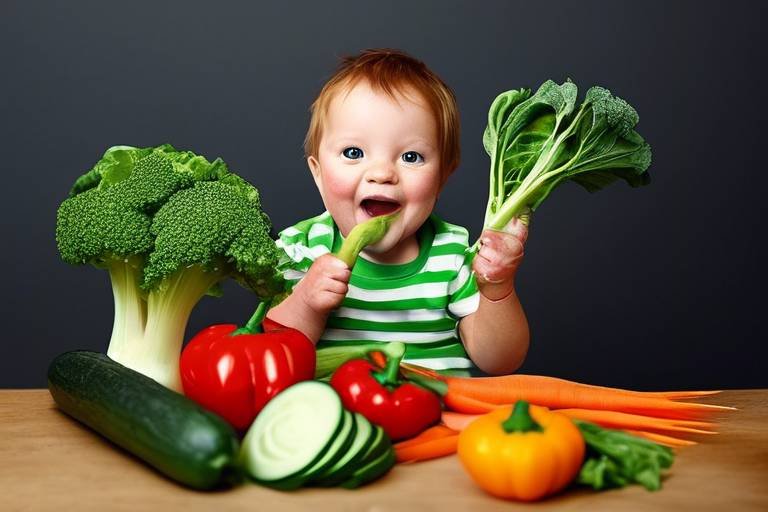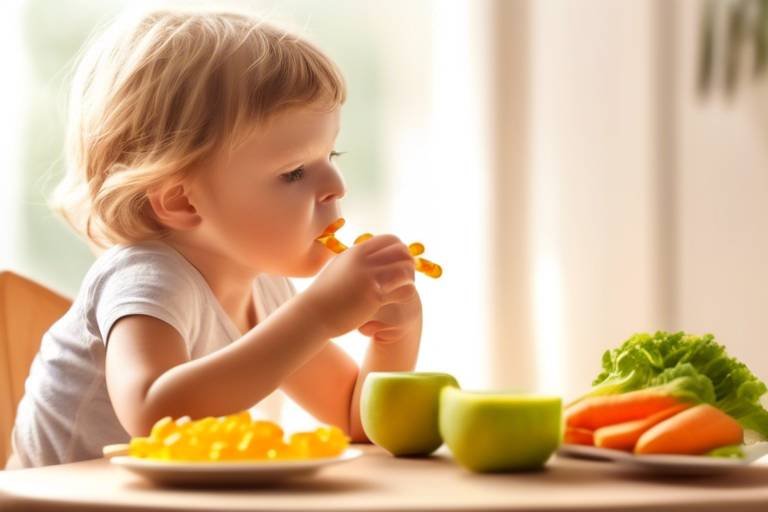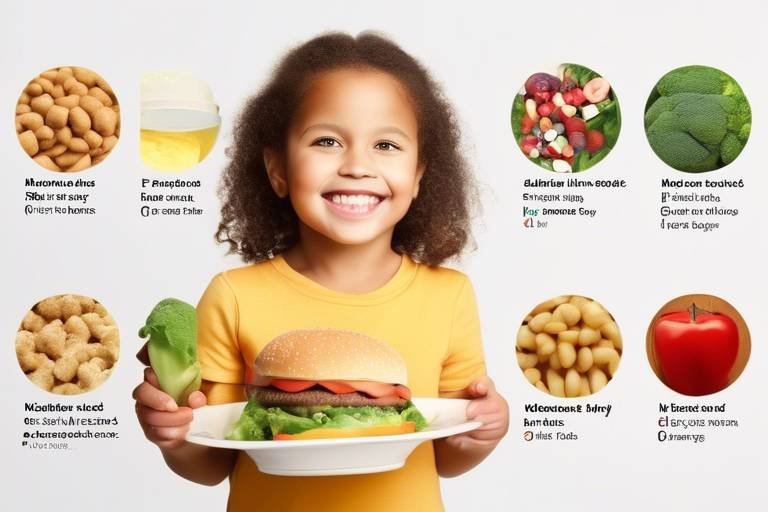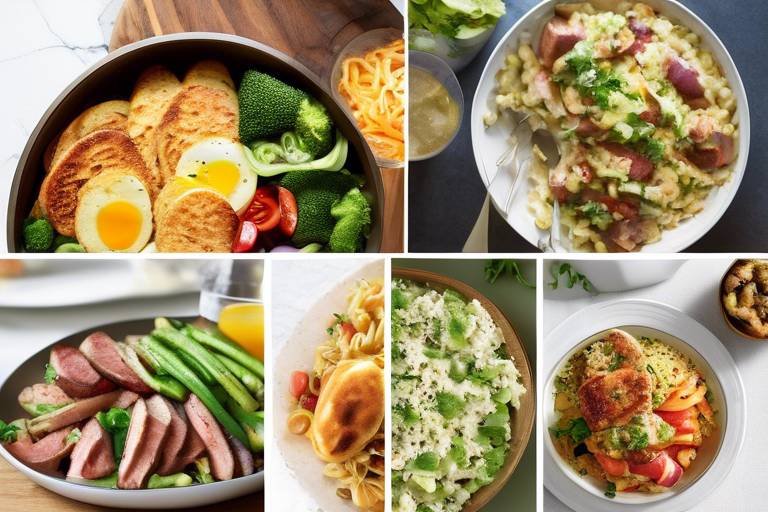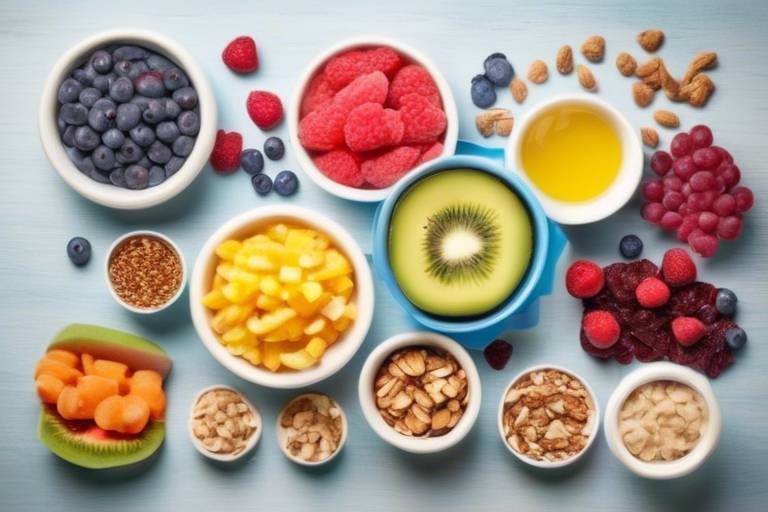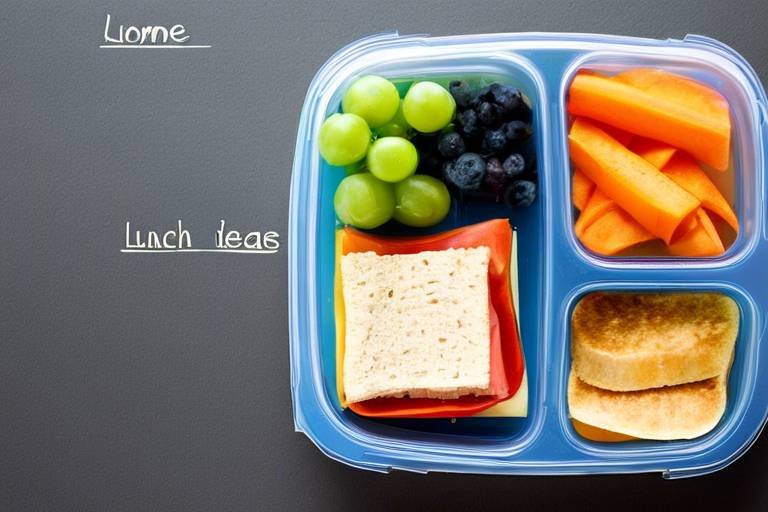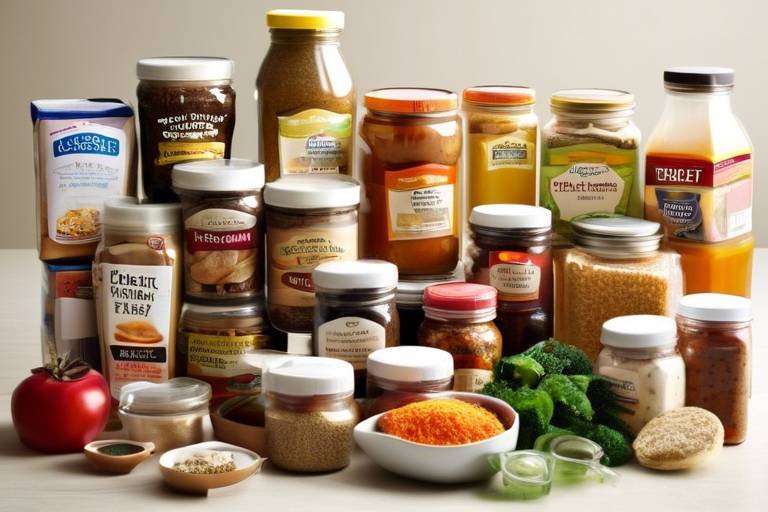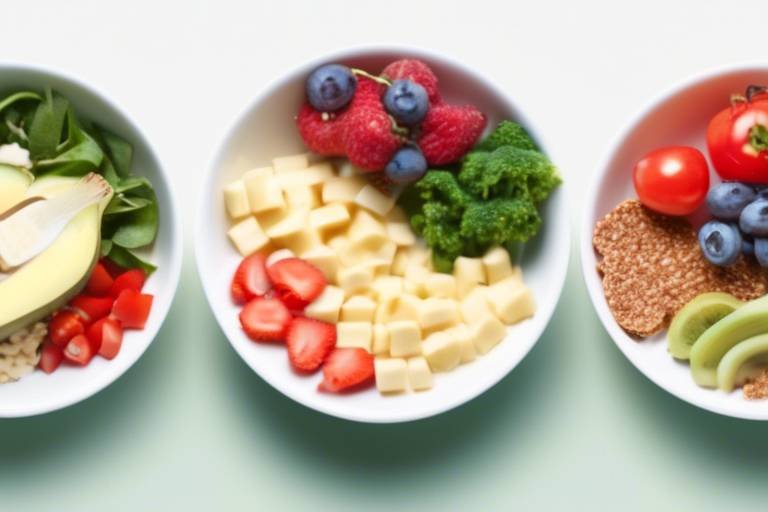Balancing Carbs and Protein in Your Child's Diet
As parents, we all want to ensure our children are growing up healthy and strong, and one of the key components to achieving this is by balancing carbohydrates and proteins in their diets. Think of carbs and proteins as the dynamic duo of nutrition—each playing a vital role in your child's energy levels, growth, and overall health. But how do we strike the right balance? In this article, we'll dive deep into the importance of these macronutrients, explore various sources, and provide practical tips to make meal planning a breeze for busy families.
Carbohydrates are like the fuel that keeps your child's engine running. They are essential for providing energy, especially for active kids who are constantly on the go. There are two main types of carbohydrates: simple and complex. Simple carbs, found in sugary snacks and drinks, can give a quick energy boost but often lead to a crash later on. On the other hand, complex carbs, like whole grains, fruits, and vegetables, offer sustained energy and are packed with nutrients. When selecting carbs for your child, aim for whole, unprocessed options that are rich in fiber. This not only supports energy levels but also promotes healthy digestion.
Now, let’s talk about protein—the building block of growth and development. Protein is crucial for your child’s muscles, bones, and overall bodily functions. There are two primary sources of protein: animal-based and plant-based. Animal proteins, such as meat, dairy, and eggs, provide complete proteins, meaning they contain all the essential amino acids that your child needs. Plant-based proteins, like beans, lentils, and nuts, are also fantastic options and can be combined to create complete protein sources. Incorporating a variety of protein sources in your child’s diet ensures they receive the necessary nutrients for optimal growth.
Animal-based proteins are not only delicious but also offer a rich source of essential amino acids. Foods like chicken, turkey, fish, and eggs are packed with nutrients that support your child's growth. For instance, fish is loaded with omega-3 fatty acids, which are excellent for brain development. To include these proteins in your child's meals, consider making a hearty chicken stir-fry or a fish taco night. The key is to make it fun and interactive, encouraging your child to explore different flavors and textures.
When it comes to selecting meats, opting for lean cuts can significantly reduce saturated fat intake, making meals healthier. Look for options like skinless chicken breast, turkey, or lean cuts of beef. These choices not only provide high-quality protein but also help maintain a healthy weight. To make lean meats more appealing, try marinating them in flavorful spices or herbs before grilling or baking. This way, you can keep your child's meals exciting while ensuring they get the nutrients they need.
Dairy products are another fantastic source of protein for children. Foods like milk, yogurt, and cheese are not only rich in protein but also provide calcium for strong bones. Incorporating these into your child's daily meals can be as simple as adding yogurt to smoothies or serving cheese as a snack. For a fun twist, you can create a yogurt parfait layered with fruits and granola. This not only boosts protein intake but also makes for a visually appealing treat!
With the rise of plant-based diets, it’s essential to recognize the benefits of plant-based proteins for children's health. Foods like beans, lentils, quinoa, and tofu are excellent sources of protein and are often lower in fat compared to animal products. These proteins can be easily integrated into meals; for example, a delicious bean chili or a quinoa salad can make for a hearty and nutritious dish. Plus, they offer a variety of flavors that can keep your child’s palate excited.
Finding the right balance between carbohydrates and proteins is crucial for your child’s overall health. A well-rounded meal should ideally include a source of protein, a healthy carbohydrate, and plenty of vegetables. For instance, consider a plate with grilled chicken (protein), brown rice (carbohydrate), and steamed broccoli (vegetable). This combination not only provides a balanced meal but also ensures your child gets a variety of nutrients.
Effective meal planning can help parents strike that balance between carbs and proteins. One strategy is to prepare meals in advance, which can save time during busy weekdays. Consider dedicating a day to batch-cook protein sources, like grilled chicken or lentils, and then mix and match them with different carbs throughout the week. This approach not only simplifies meal prep but also encourages your child to try new combinations.
Snacks play a significant role in children’s diets, providing energy between meals. When choosing snacks, aim for options that combine both carbohydrates and proteins. For example, try apple slices with peanut butter, yogurt with granola, or whole grain crackers with cheese. These snacks are not only delicious but also help keep your child energized throughout the day.
Q: How can I encourage my child to try new protein sources?
A: Get creative! Involve your child in cooking and let them choose a new recipe to try. Make it a fun family activity!
Q: Are there any snacks that are both healthy and appealing to kids?
A: Absolutely! Try making homemade trail mix with nuts, seeds, and dried fruits. It's nutritious and can be customized to your child's taste.

The Importance of Carbohydrates
Carbohydrates are more than just a source of energy; they are the fuel that powers your child's growth and daily activities. Imagine trying to run a car without gas—it's simply not going to work! Similarly, without adequate carbohydrates, children may feel tired, irritable, and unable to concentrate. This is why it's crucial for parents to understand not only the role of carbs but also how to choose the right types for their little ones.
When we talk about carbohydrates, we generally categorize them into two main types: simple and complex. Simple carbohydrates, found in sugary snacks and drinks, provide quick bursts of energy but can lead to crashes, leaving kids feeling sluggish. On the other hand, complex carbohydrates, which are found in whole grains, fruits, and vegetables, release energy more steadily and are packed with essential nutrients like fiber, vitamins, and minerals. Think of complex carbs as the slow-burning logs in a fire, providing warmth and energy over a longer period.
So, how do we ensure our children are getting the right kind of carbs? Here are a few tips:
- Opt for whole grains: Instead of white bread or pasta, choose whole grain options. These not only provide energy but also keep kids feeling full longer.
- Incorporate fruits and vegetables: These are not just for decoration on the plate! They offer vital nutrients and fiber that help with digestion and overall health.
- Limit sugary snacks: While a sweet treat now and then is okay, try to keep them to a minimum. Instead, opt for healthier alternatives like fruit smoothies or yogurt with honey.
Incorporating a variety of carbohydrates into your child's diet can also make mealtime more exciting. For instance, you can create colorful plates filled with brown rice, roasted vegetables, and a side of fresh fruit. Not only does this provide essential nutrients, but it also makes the meal visually appealing, encouraging children to try new foods. Remember, the more colorful the plate, the more nutrients it likely contains!
Furthermore, understanding the timing of carbohydrate intake can also play a significant role in your child's energy levels throughout the day. For example, serving a hearty breakfast that includes complex carbs can help kickstart their day, providing them with the energy they need for school and play. Similarly, a balanced lunch with whole grains can keep them focused and alert in the afternoon.
In conclusion, carbohydrates are an essential part of a child's diet, fueling their bodies and minds. By making informed choices and focusing on whole, nutrient-rich sources, parents can help ensure their children have the energy they need to thrive. Just remember, when it comes to carbs, it's all about quality over quantity!

Understanding Protein Sources
When it comes to fueling our little ones, protein is a superstar nutrient that plays a pivotal role in their growth and development. But what exactly does protein do? Think of it as the building blocks for your child's body, helping to form muscles, skin, and even their organs. It's crucial for their overall health and well-being. So, how do we ensure our kids are getting enough of this essential nutrient? Let's dive into the various sources of protein available and how to incorporate them into their diets.
Protein sources can be broadly categorized into two groups: animal-based and plant-based. Each of these sources offers unique benefits and can be included in meals in creative and delicious ways. Animal-based proteins, such as meat, dairy, and eggs, are packed with essential amino acids that our bodies can't produce on their own. These amino acids are vital for many bodily functions, including repairing tissues and making hormones. On the other hand, plant-based proteins are gaining popularity, not just for their health benefits but also for their environmental impact. Foods like beans, lentils, nuts, and seeds can provide substantial protein while also being rich in fiber, vitamins, and minerals.
Now, let's take a closer look at some of the most common protein sources:
| Protein Source | Type | Benefits |
|---|---|---|
| Chicken | Animal | Lean source of protein, low in fat |
| Fish | Animal | Rich in omega-3 fatty acids, good for brain development |
| Eggs | Animal | Complete protein, versatile in cooking |
| Beans | Plant | High in fiber, great for digestion |
| Quinoa | Plant | Complete protein, gluten-free |
| Nuts | Plant | Healthy fats, good for heart health |
Incorporating these protein sources into your child's meals can be both fun and rewarding. For instance, you can create a delicious chicken stir-fry loaded with colorful vegetables or whip up a hearty bean chili that warms the soul. The key is to mix and match these sources to keep meals exciting and nutritious. Remember, variety is the spice of life!
It's also important to consider your child's dietary preferences and any potential food allergies. For example, if your child is a vegetarian or has a dairy intolerance, you might focus more on plant-based proteins like lentils, chickpeas, and tofu. These foods can easily be incorporated into salads, soups, and even smoothies. Just like a painter needs a palette of colors, you’ll want a range of protein sources to ensure your child gets the nutrients they need.
In conclusion, understanding the different protein sources available and how to incorporate them into your child's diet is crucial for their growth and health. By providing a balance of both animal and plant-based proteins, you can help your child develop a strong foundation for a healthy lifestyle. So, the next time you're planning meals, remember the power of protein and get creative in the kitchen!

Animal-Based Proteins
When it comes to fueling our children's growth and development, play a pivotal role. These proteins are not just about building muscles; they provide essential amino acids that are crucial for various bodily functions. Think of amino acids as the building blocks of life—they help in everything from repairing tissues to producing hormones. So, how do we make sure our kids are getting enough of these vital nutrients? Let's dive into the world of animal-based proteins and explore their benefits.
First off, animal proteins come from a variety of sources, including meat, dairy, and eggs. Each of these sources has its unique set of advantages. For instance, lean meats like chicken and turkey are packed with protein while being lower in saturated fats compared to red meats. This makes them an excellent choice for growing kids who need energy without the extra calories. On the other hand, dairy products, such as milk and yogurt, not only provide protein but are also rich in calcium, which is vital for strong bones. Eggs are another powerhouse, offering a complete protein source that is versatile and easy to prepare.
Including animal-based proteins in your child's diet doesn't have to be a chore. Here are some tips to make it easier:
- Start the day with a protein-rich breakfast like scrambled eggs or Greek yogurt topped with fruit.
- For lunch, pack a turkey sandwich on whole-grain bread or a chicken salad with plenty of colorful veggies.
- At dinner, consider grilled chicken or fish paired with a side of quinoa or brown rice for a balanced meal.
Moreover, it's essential to consider the quality of the animal proteins you choose. Opting for grass-fed or organic meats can offer additional health benefits, such as higher levels of omega-3 fatty acids and fewer harmful additives. When it comes to dairy, look for options that are low-fat or fat-free to ensure your child is getting the nutrients without the extra saturated fat.
Incorporating these proteins into your child's diet can be fun and creative. For instance, you can make a delicious smoothie with yogurt and fruit, or prepare a cheese platter for a snack that’s both nutritious and appealing. The key is to keep meals varied and colorful, which not only makes them more enjoyable but also ensures a broader range of nutrients.
In conclusion, animal-based proteins are an essential component of a child's diet. They support growth, provide energy, and contribute to overall health. By choosing high-quality sources and incorporating them into meals in fun and creative ways, parents can ensure their children are getting the best nutrition possible. So, why not start experimenting with different animal protein sources today? Your child's health will thank you!

Choosing Lean Meats
When it comes to ensuring your child has a balanced diet, is a crucial step. Lean meats are not just flavorful; they are also packed with essential nutrients that support your child's growth and development. But what exactly makes a meat "lean"? Generally, lean meats contain less fat compared to their fattier counterparts, which means they provide high-quality protein without the extra calories from saturated fats. This is especially important for children, as their bodies need protein for building muscles, repairing tissues, and producing hormones.
So, how can you incorporate lean meats into your child's meals? First, let’s look at some great options. Chicken breast, turkey, and pork tenderloin are excellent choices. These meats are not only low in fat but also versatile and can be prepared in numerous ways. For instance, grilled chicken can be added to salads, or turkey can be used in tacos. It's all about getting creative in the kitchen!
Additionally, when selecting meat at the grocery store, it's essential to read labels carefully. Look for terms like "90% lean" or "extra lean" on ground meats. These labels indicate that the product has less fat, making it a healthier choice for your little ones. You might also want to consider the cooking methods you use. Baking, grilling, or steaming meats can help keep them lean, while frying can add unnecessary fats.
Here’s a quick comparison of some common meats and their fat content:
| Type of Meat | Serving Size | Fat Content (g) |
|---|---|---|
| Chicken Breast (skinless) | 3 oz | 3.0 |
| Turkey Breast (skinless) | 3 oz | 1.0 |
| Pork Tenderloin | 3 oz | 3.5 |
| Beef (round steak) | 3 oz | 5.0 |
In summary, choosing lean meats is a fantastic way to provide your child with the protein they need without the extra fat. It's all about making informed choices and being mindful of how you prepare these foods. So next time you’re at the grocery store, remember to look for those lean options, and watch how easy it is to whip up delicious, healthy meals that your kids will love!
- What are some examples of lean meats? Lean meats include skinless chicken breast, turkey breast, pork tenderloin, and certain cuts of beef like round steak.
- How can I cook lean meats to keep them healthy? Opt for cooking methods like grilling, baking, or steaming instead of frying to maintain their health benefits.
- Is it necessary to remove the skin from chicken? Yes, removing the skin significantly reduces the fat content, making it a healthier option for your child.

Incorporating Dairy Products
Dairy products are not just delicious; they are also nutritional powerhouses that play a crucial role in your child's diet. Rich in essential nutrients like calcium, vitamin D, and protein, dairy can significantly contribute to your child's growth and development. For parents, incorporating dairy into meals can be both simple and enjoyable. Think about it—who doesn't love a creamy yogurt parfait or a cheesy quesadilla? These tasty options not only satisfy your child's taste buds but also pack a nutritious punch!
When considering how to incorporate dairy products into your child's diet, it's essential to explore a variety of options. Milk, cheese, and yogurt are the most common sources, but don't overlook the potential of fortified dairy alternatives, such as almond or soy milk, especially for kids with lactose intolerance. These alternatives can still provide valuable nutrients, making them viable options for your family. However, always check the labels to ensure they are fortified with calcium and vitamin D, similar to traditional dairy products.
One of the best ways to include dairy in your child's meals is through creative cooking. For instance, you can blend yogurt into smoothies, sprinkle cheese on vegetables, or use milk in pancake or waffle batter. This not only enhances the flavor but also boosts the nutritional value of the meal. Here are a few ideas to get you started:
- Breakfast: Start your day with a bowl of oatmeal topped with milk and a dollop of yogurt, or serve whole-grain pancakes with a side of cottage cheese.
- Lunch: Add cheese slices to sandwiches or include a yogurt dip with fresh veggies for a fun twist.
- Dinner: Incorporate dairy into casseroles or pasta dishes, where cheese can melt beautifully and add flavor.
Moreover, it's important to pay attention to portion sizes. The American Academy of Pediatrics recommends that children aged 2-3 years consume about 2 cups of dairy per day, while kids aged 4-8 should aim for 2.5 cups. This can easily be achieved by serving milk at meals, offering yogurt as a snack, or including cheese in various dishes. Remember, moderation is key; too much dairy can lead to an imbalance in nutrients, so make sure to balance it with other food groups.
Incorporating dairy products into your child's diet can also be a fantastic opportunity to teach them about nutrition. Involve them in the process by letting them choose their favorite dairy products at the grocery store or helping to prepare meals. This not only makes them more likely to eat what you serve but also empowers them to make healthier choices in the future.
In conclusion, dairy products are a delicious and essential component of a balanced diet for children. By incorporating a variety of dairy sources and being creative in the kitchen, you can ensure your child receives the nutrients they need for healthy growth and development. So, why not whip up a cheesy dish or a creamy smoothie today? Your child—and their growing bones—will thank you!
1. What are the best dairy options for children?
The best dairy options include low-fat milk, yogurt, and cheese. Look for products that are low in added sugars and high in calcium and vitamin D.
2. What if my child is lactose intolerant?
If your child is lactose intolerant, consider lactose-free milk or dairy alternatives like almond, soy, or oat milk that are fortified with calcium and vitamin D.
3. How can I encourage my child to eat more dairy?
Get creative with meals! Use yogurt in smoothies, cheese in quesadillas, or serve milk with breakfast. Involving them in meal prep can also spark their interest.
4. Is it possible to get enough calcium without dairy?
Yes, there are many non-dairy sources of calcium, such as leafy greens, fish with bones, almonds, and fortified plant-based milks. However, dairy is one of the easiest sources to include in a child's diet.

Plant-Based Proteins
In the world of nutrition, are gaining immense popularity, and for good reason! These proteins are not only beneficial for our health but also for the environment. When it comes to children's diets, incorporating plant-based proteins can be a game-changer. They are packed with essential nutrients, fiber, and antioxidants, all of which contribute to a child's overall well-being.
So, what exactly are plant-based proteins? They come from a variety of sources, including beans, lentils, nuts, seeds, and whole grains. These foods provide the necessary building blocks for growth and development, making them an excellent choice for young, growing bodies. For instance, lentils are a powerhouse of protein and can easily be added to soups, salads, or even made into delicious lentil burgers. Similarly, chickpeas can be transformed into hummus, which is not only tasty but also a great dip for veggies!
One of the fantastic things about plant-based proteins is their versatility. They can be easily incorporated into meals without much fuss. For example, consider mixing quinoa, which is a complete protein, with your child's favorite vegetables for a colorful and nutritious bowl. Or, you can sprinkle some chia seeds on yogurt or smoothies for an added protein boost. The options are endless!
It's also important to note that plant-based proteins can be a great alternative for children who may have dietary restrictions or allergies to animal products. However, parents should be mindful of ensuring that their children receive a variety of protein sources to cover all essential amino acids. While most plant proteins are considered incomplete, meaning they lack one or more essential amino acids, combining different sources can create a complete protein profile. For example, pairing rice with beans or peanut butter with whole-grain bread can provide a complete amino acid profile, which is crucial for growth.
Here’s a quick overview of some popular plant-based protein sources and their protein content per serving:
| Food Item | Protein Content (per 100g) |
|---|---|
| Lentils | 9g |
| Chickpeas | 8g |
| Quinoa | 4g |
| Almonds | 21g |
| Chia Seeds | 17g |
In conclusion, plant-based proteins are a fantastic way to ensure that your child is getting the necessary nutrients for their growth and energy needs. By incorporating a variety of these proteins into their diet, you not only promote their health but also introduce them to a world of flavors and textures. So next time you’re planning meals, consider how you can creatively incorporate more plant-based proteins for your little ones!

Balancing Carbs and Proteins
Finding the right balance between carbohydrates and proteins in your child's diet is essential for their overall health and development. Think of carbs as the fuel for a car; they provide energy for children to play, learn, and grow. On the other hand, proteins are like the building blocks that help repair and build tissues, ensuring that your child grows strong and healthy. Striking the right balance can be a bit tricky, but with some practical tips and a little creativity in the kitchen, it can be done!
First off, it's important to recognize that not all carbs are created equal. Simple carbohydrates, like those found in sugary snacks and sodas, can lead to energy spikes followed by crashes, leaving your child feeling lethargic and cranky. Instead, focus on complex carbohydrates such as whole grains, fruits, and vegetables. These provide sustained energy and are packed with essential nutrients. Pairing these with protein can help slow down digestion, keeping your child feeling full and satisfied longer. For instance, a bowl of oatmeal topped with nuts and berries can be a great breakfast option that combines both.
When it comes to proteins, variety is key. Incorporating both animal-based and plant-based proteins ensures that your child receives a wide array of amino acids, which are vital for growth and development. Animal proteins, such as chicken, fish, and dairy, are complete proteins, meaning they contain all the essential amino acids. On the flip side, plant-based proteins like beans, lentils, and quinoa can also be excellent choices, especially for vegetarian families. The goal is to create meals that are colorful and diverse, allowing your child to enjoy a range of flavors while meeting their nutritional needs.
To help you visualize how to balance these nutrients, consider the following meal planning tips:
| Meal | Carbohydrates | Proteins |
|---|---|---|
| Breakfast | Whole grain toast | Scrambled eggs |
| Lunch | Brown rice | Grilled chicken |
| Dinner | Quinoa salad | Chickpeas |
As you can see, each meal can include a healthy portion of both carbs and proteins, ensuring your child gets the energy they need along with the nutrients necessary for growth. It's also a good idea to involve your child in meal planning and preparation. This not only teaches them about healthy eating habits but also encourages them to try new foods. When kids help make their meals, they're often more willing to eat what’s served!
Lastly, don't forget about snacks! Healthy snacks can bridge the gap between meals and keep energy levels stable throughout the day. Aim for snacks that combine both carbs and proteins, such as:
- Apple slices with peanut butter
- Greek yogurt with honey and granola
- Whole grain crackers with cheese
In conclusion, balancing carbohydrates and proteins in your child’s diet is not just about the numbers; it's about creating a wholesome, enjoyable eating experience that supports their growth and energy needs. By making informed choices and being mindful of the foods you serve, you can help your child thrive both physically and mentally!
Q1: How can I ensure my child is getting enough protein?
A1: Incorporate a variety of protein sources into their meals, including meat, dairy, beans, and nuts. Aim for protein-rich snacks as well.
Q2: Are carbohydrates bad for my child?
A2: Not at all! Carbohydrates are essential for energy. Just focus on complex carbs over simple sugars for better nutrition.
Q3: How can I make healthy meals fun for my kids?
A3: Get creative! Use colorful ingredients, involve them in cooking, and try themed meals to make healthy eating exciting.

Meal Planning Tips
Meal planning can feel like a daunting task, especially for busy parents juggling work, school, and extracurricular activities. However, it’s a crucial step in ensuring that your child receives a well-rounded diet rich in both carbohydrates and proteins. Think of meal planning as a roadmap to healthy eating—it guides you through the week, helping you avoid those last-minute takeout temptations that often lead to less nutritious choices.
Start by dedicating some time each week to plan out your meals. This doesn’t have to be an elaborate process; a simple outline can do wonders. Consider using a calendar or a meal planning app to jot down your ideas. Aim for a balance of carbs and proteins in each meal. For example, if you’re planning pasta for dinner, think about adding grilled chicken or beans to the sauce. This not only enhances the meal's flavor but also boosts its nutritional value.
Another effective strategy is to incorporate a variety of food groups into your meals. This means mixing different types of proteins and carbohydrates. For instance, you could pair quinoa (a great source of protein) with roasted vegetables and chickpeas for a hearty salad. Or, serve whole-grain bread with turkey and avocado for a satisfying sandwich. The key is to make meals visually appealing and tasty, as children are more likely to eat what looks good on their plates.
Don’t forget about snacks! Healthy snacks can bridge the gap between meals and keep your child energized. Think about options that combine both carbs and proteins, such as:
- Greek yogurt with honey and berries
- Apple slices with peanut butter
- Whole-grain crackers with cheese
These combinations not only satisfy hunger but also provide essential nutrients. When planning snacks, involve your children in the process. Let them choose fruits or veggies they enjoy, and offer a variety of dips, like hummus or yogurt, to make healthy snacking more fun.
Lastly, consider batch cooking. Preparing meals in advance can save time during busy weekdays. You can cook larger portions of proteins and carbohydrates, then mix and match them throughout the week. For instance, grill a batch of chicken on Sunday and use it in salads, wraps, or pasta dishes over the next few days. This not only simplifies meal prep but also ensures that your child has access to nutritious options at all times.
In summary, meal planning doesn’t have to be overwhelming. By taking a few simple steps—planning ahead, incorporating a variety of food groups, making snacks fun, and batch cooking—you can create a balanced diet for your child that includes the right amounts of carbohydrates and proteins. It's all about making smart choices and keeping it enjoyable!
Q: How can I ensure my child is getting enough protein?
A: Incorporate a variety of protein sources into their diet, such as lean meats, dairy, legumes, and nuts. Aim for protein-rich snacks like yogurt or nut butter to boost their intake.
Q: What are some good sources of carbohydrates for children?
A: Focus on whole grains, fruits, and vegetables. Foods like brown rice, whole-grain bread, and oats are excellent choices that provide energy and essential nutrients.
Q: How can I make healthy meals appealing to my child?
A: Get creative with colors and presentation. Involve your child in the cooking process, and let them help choose ingredients. Fun shapes and vibrant colors can make meals more exciting!
Q: Is it okay for my child to have snacks?
A: Yes! Healthy snacks are important for maintaining energy levels throughout the day. Just make sure to choose options that combine both carbohydrates and proteins for balanced nutrition.

Healthy Snack Ideas
When it comes to keeping our little ones energized throughout the day, healthy snacks are a game changer! But what does a healthy snack look like? It's all about finding that sweet spot between carbohydrates and proteins. The right mix not only satisfies hunger but also fuels their bodies for play and learning. Think of snacks as mini-meals that can boost their mood and concentration. So, let’s dive into some delicious and nutritious snack ideas that are sure to please even the pickiest eaters!
First off, let’s talk about fruits and nuts. Combining these two powerhouse snacks can create a delightful treat. For instance, sliced apples with a dollop of peanut butter offer a crunchy, sweet experience while packing a protein punch. Similarly, a banana paired with a handful of almonds can provide sustained energy, perfect for those after-school activities. Not to mention, it’s super easy to prepare! Just grab the fruit, scoop some nut butter, and voilà—snack time!
Another fantastic idea is yogurt parfaits. Layering Greek yogurt with fresh fruits and a sprinkle of granola not only looks appealing but also provides a balanced snack. The yogurt is rich in protein, while the fruits offer essential vitamins and the granola adds that satisfying crunch. You can even let your child help with the assembly—after all, kids are more likely to eat what they’ve helped create!
For those days when you need something quick and easy, consider whole grain toast topped with avocado and a sprinkle of cheese. This combo is not just delicious but also delivers healthy fats along with protein. Avocado is like nature’s butter, creamy and packed with nutrients. Plus, it’s a fun way to introduce kids to new flavors!
Now, if you’re looking for something a bit more substantial, homemade energy balls can be a hit! These little bites are typically made from a mix of oats, nut butter, honey, and whatever add-ins your child loves, like chocolate chips or dried fruit. They’re easy to make, require no baking, and can be stored in the fridge for a quick grab-and-go option. Just imagine the joy on their faces when they realize they get to enjoy a treat that’s also good for them!
Lastly, let’s not forget about veggies! Pairing carrot sticks, cucumber slices, or bell pepper strips with hummus can create a colorful, crunchy snack that’s both fun and healthy. Hummus is a fantastic source of plant-based protein and can be flavored in various ways to keep things interesting. Think of it as a dip party—who doesn’t love a good dip?
In summary, healthy snacks don’t have to be boring or complicated. By incorporating a variety of carbohydrates and proteins, you can create snacks that are not only nutritious but also enjoyable for your kids. Remember, the goal is to keep them fueled and happy, so get creative in the kitchen and have fun with it!
- What are some quick healthy snacks for kids?
Some quick options include fruit with nut butter, yogurt parfaits, and whole grain toast with avocado.
- How can I make vegetables more appealing to my child?
Pairing veggies with dips like hummus or yogurt can make them more enticing!
- Are store-bought snacks healthy?
It depends! Always check the labels for added sugars and preservatives. Opt for snacks with whole ingredients when possible.
Frequently Asked Questions
- What are the best sources of carbohydrates for children?
When it comes to carbohydrates, think of whole grains, fruits, and vegetables as your best friends! Whole grain bread, brown rice, oats, and quinoa are fantastic options. They provide not just energy but also fiber, which is great for digestion. And let’s not forget about fruits and veggies—they're packed with vitamins and minerals, making them a delicious way to fuel your child’s day!
- How much protein does my child need daily?
The amount of protein your child needs can vary based on their age, weight, and activity level. Generally, kids need about 1.1 to 1.5 grams of protein per kilogram of body weight. So, for a child weighing 30 kg, that’s roughly 33 to 45 grams of protein a day. It’s all about balance, so try to include a variety of protein sources in their meals!
- Can my child get enough protein from a vegetarian diet?
Absolutely! A vegetarian diet can provide all the protein your child needs, as long as it’s well-planned. Foods like beans, lentils, tofu, nuts, seeds, and dairy products (if they consume them) are excellent sources of protein. Mixing different plant-based proteins throughout the day can ensure they get all the essential amino acids they need for growth and development.
- What are some healthy snack ideas that balance carbs and protein?
Snacks can be a fun way to sneak in nutrition! Try pairing apple slices with peanut butter, yogurt with berries and granola, or whole grain crackers with cheese. These combos provide a great balance of carbohydrates and proteins, keeping your little ones energized and satisfied between meals!
- How can I help my child develop healthy eating habits?
Start by being a role model! Kids often mimic their parents’ behavior, so show them how to enjoy a variety of foods. Involve them in meal planning and preparation, and make it a fun family activity. Encourage them to try new foods and explain the benefits of a balanced diet in a way they can understand. Remember, it’s all about making healthy eating enjoyable!

